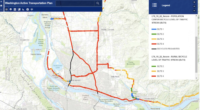
When the 57.5-ft-dia earth-pressure-balance tunnel-boring-machine called Bertha reaches Seattle from Japan next month, it will make its debut at a 400-ft-long, 80-ft-wide and 80-ft-deep launch pit that crews have been toiling on for months. The 6,700-ton, 326-ft-long tunneler's arrival will be a key milestone in the $3.1-billion, 12-project program to replace the Alaskan Way Viaduct.
The TBM—named for Bertha Knight Landes, Seattle's first female mayor—is traveling across the ocean in 41 medium-sized blocks, says Chris Dixon, project manager with Seattle Tunnel Partners (STP), the joint venture of Tutor Perini Corp. and Dragados USA that is building the $1.5-billion, 1.7-mile double-stacked tunnel. Built by Hitachi Zosen Corp. in Osaka, Bertha "is an $80-million machine that incorporates all the advancements that have been made in tunneling technology in the last 10 to 15 years," Dixon says.
Upon arrival at the Port of Seattle, Bertha will be transported by self-propelled modular transporters to the launch pit, a dewatered "bathtub" supported by tiebacks and concrete struts, for assembly. The team secured five acres at the port for the job's staging area, relocating existing port facilities, he adds.
The other 11 projects in the new state Route 99 program include building new overpasses, realigning streets and eventually demolishing the viaduct, says Linea Laird, program administrator for the Washington State Dept. of Transportation (WSDOT). In 2010, Skanska USA Civil won the first contract, at $114-million, to rebuild the southern mile of the viaduct to allow for the launch pit.
STP won the coveted design-build contract in 2010 in part for its proposal to finish the tunnel in 2015—a year early, she says. It could earn up to $25 million in schedule incentives for early completion or face $50,000 a day in liquidated damages for late completion. WSDOT provides a $20-million settlement-mitigation and repair fund; the design-build team is eligible to collect up to 75% of any unused funds.
"It's a $1.4-billion job, and it involves boring the world's largest-diameter tunnel to date," says Jack Frost, chief executive officer of Tutor Perini's civil group. "It's very geologically complex."
When she begins excavating this summer, Bertha will encounter water-filled soils, glacial tills, tough clays and boulders, says Rich Johnson, an HNTB Corp. vice president and design manager for the joint venture. "Time was one of the largest challenges" in designing the tunnel, he notes. "We got the draft request for proposals in February 2010 and a notice to proceed one year later."
At peak, 600 crew members will toil five days a week, 20 hours a day. The tunnel will dip as deep as 200 ft, snaking through Seattle's dense environs, including 158 buildings in areas prone to settlement, says Dixon. The team anticipates 1,440 hours of tunneling, including cutterhead maintenance. WSDOT provides a $40-million fund for differing site conditions beyond the allotted time.



Post a comment to this article
Report Abusive Comment